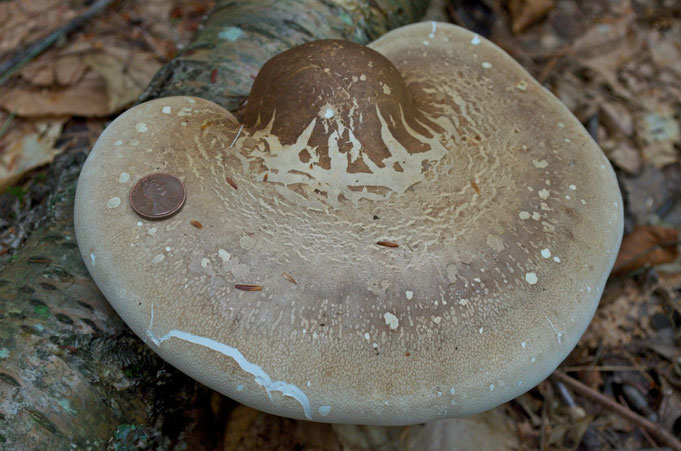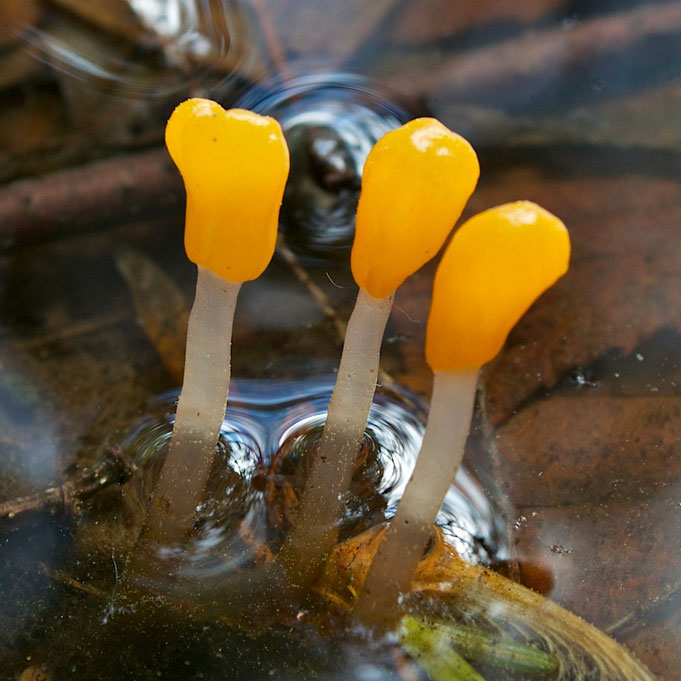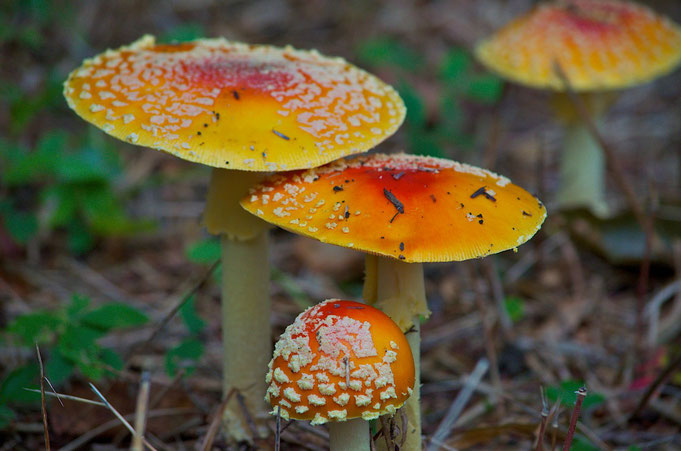fungi/mushrooms · August 30, 2014
I noticed this tiny fungus growing in the grass on my way to the swimming pond recently. Cyathus striatus, commonly known as Fluted Bird's Nest, is a common bird's nest fungus with a widespread distribution throughout temperate regions of the world. Fluted Bird's Nest can be distinguished from other bird's nest fungi by its hairy exterior and fluted inner walls. Cyathus striatus is a saprobic fungus, deriving its nutrition from decaying organic material, and is typically found growing in...
fungi/mushrooms · February 24, 2014
According to Wikipedia the Common Split Gill (Schizophyllum commune) is the world's most widely distributed mushroom, occurring on every continent except Antarctica. It is found predominantly from autumn to spring on dead wood, in coniferous and deciduous forest. Often when fungi appear to be similar but occur on widely separated continents, DNA analysis shows that their genetic separation is so great that they should be classified as distinct species. Thanks to the work of John Raper and...
fungi/mushrooms · December 10, 2013
Piptoporus betulinus, the Birch Poypore, develops from a small white spherical swelling on the side of dead or living birch trees. It quickly grows into a large shelf-shaped mushroom up to 10 inches (25cm) across. Barbers used to 'strop' or sharpen their razors on strips cut from these polypores, and so they are also sometimes called Razor Strop Fungus. An extremely useful medicinal fungi, Birch Poypore has anti-inflammatory and antibacterial properties. It also contains compounds that are...
fungi/mushrooms · November 20, 2013
Chaga is nothing like a common soft Mushroom. It almost as hard as wood. Known in Russia as the “Gift from God” and the “Fungi of Immortality,” chaga has been used medicinally for thousands of years. The Japanese call it “The Diamond of the Forest,” while in China it is known as the “King of Plants.” Chaga, Inonotus obliquus, is also known as clinker polypore, cinder conk, black mass and birch canker polypore. It is a parasitic fungi on birch and other trees. The sterile conk is...
fungi/mushrooms · September 01, 2013
Gem-studded puffball, Lycoperdon perlatum, are also known as common puffball, warted puffball, or the devil's snuff-box. Puffballs are considered to be a good edible mushroom when young, when the gleba or inside is still homogeneous and white. Nutritional analysis of puffballs indicates that they are a good source of protein, carbohydrates, fats, and several micronutrients.
fungi/mushrooms · June 20, 2013
Slime mold is often called "hands and knees fungi" because it helps to be on your hands and knees to see them well. There are over 700 named varieties of these fungus-like organisms. They vary drastically in their size, shape and color and are found during periods of very wet weather.
fungi/mushrooms · June 14, 2013
Swamp Beacons are the club-shaped fruiting body of the Mitrula elegans fungus. They grow in marshy and wet areas either solitary or in groups, and are often found growing directly in shallow standing water. Appearing in the late spring or early summer, they sport an irregular blob-like orange/yellow cap, with a stem that is smooth, straight, and translucent white. Up to 2 inches tall (5 cm), Mitrula elegans is a ‘recycler’ fungus, feeding on dead and decaying plant litter. They play a vital...
fungi/mushrooms · April 15, 2013
On one of the first days this spring with no snow cover on the ground, I noticed this group of Scarlet Elf Cup Mushrooms (Sarcoscypha coccinea) on the forest floor. This medium to large mushroom, with its bright scarlet stalked cups, fruits in very early spring, often rising through the snow. These mushrooms are widely distributed in hardwood forests east of the Rocky Mountains, and along the West coast. The Scarlet Elf Cup is a saprobic species, growing on rotting wood. Basswood (Tilia) is the...
fungi/mushrooms · December 05, 2012
The Yellow-orange Fly Agaric, Amanita muscaria var. formosa, is common in the woods at Distant Hill. It is somewhat poisonous and hallucinogenic when consumed by humans, but not deadly like some species of Amanita. The toxins affect the part of the brain that is responsible for fear, turning off the fear emotion. Viking Berserkers , who had a reputation for fierceness, are said to have ingested this mushroom prior to battle. According to Wikipedia, it's called the fly agaric because residents...
fungi/mushrooms · August 31, 2012
Oyster mushrooms (Pleurotus ostreatus), are shown here growing on a dying sugar maple at Distant Hill Gardens. They are one of the easiest edible mushrooms to identify. Often found growing in large numbers, it usually doesn't take long to collect enough for a meal or two. In this case, I shared half of the find with a friend and still had enough to freeze for later. Their name comes from the fact that they resemble oysters in looks, and some say in flavor. According to Wikipedia, the genus...
Distant Hill was listed as one of the Top 10 Places to Visit in New Hampshire!
Friends of Distant Hill (dba Distant Hill Gardens and Nature Trail) is a nonprofit,
tax-exempt organization under Section 501(c)(3) of the U.S. Internal Revenue Code.
Donations are tax-deductible as allowed by law. Tax ID# 84-3765898
or send a check via Snail Mail to:
Distant Hill Gardens and Nature Trail, 507 March Hill Road, Walpole, NH 03608











